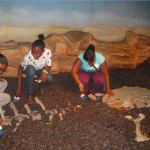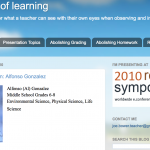 As teachers, we hope to do more than just teach kids information they need to pass tests and score well on end-of-grade exams. We hope to teach information such that the kids remember it five, ten, and even twenty years later. We hope to imbue students with useful facts and figures and to teach critical thinking skills that will help them succeed later in life. It is our collective dream that our students will someday use these facts and skills practically, that perhaps we will be the teachers they mention to their own children, saying, “I learned that in Mr. González’s class.â€
As teachers, we hope to do more than just teach kids information they need to pass tests and score well on end-of-grade exams. We hope to teach information such that the kids remember it five, ten, and even twenty years later. We hope to imbue students with useful facts and figures and to teach critical thinking skills that will help them succeed later in life. It is our collective dream that our students will someday use these facts and skills practically, that perhaps we will be the teachers they mention to their own children, saying, “I learned that in Mr. González’s class.â€
But how do we teach in such a manner that the information sticks in their heads, not for a week, but for years? How do we inspire middle school students to stop thinking about the daily dramas of junior high social interactions and actually think about a premise or theory long enough to absorb the lesson? The following are teaching methods that can help us teach science that sticks and English that enlightens (and math that matters… you get the point):
Involve the Senses
We all retain information better when we use our senses—smell, taste, hearing, touch, and sight. Kids are used to using two of their senses when learning – hearing (listening) and sight (reading), but their retention of information goes up when we let them taste, smell or feel while learning.
A study featured on “This Emotional Life†by PBS demonstrated that if you place your hand in a bucket of ice-cold water while reading something, you’ll retain that information better than if you studied without the stimulus of the cold water.
Another study proved that when students speak aloud and listen to their own words, they memorize information more efficiently. That’s why it works to make “ear phones†out of PVC pipe and duct tape so students can speak vocabulary words and listen to themselves through the “ear phonesâ€.
You can help your students by having them draw pictures to help them memorize information. For example, if your child must learn vocabulary words, drawing pictures of the definitions on one side of flash cards may help your student because the visual cues and the kinetic and creative experience of illustrating the cards will help them remember the definitions.
Ask Questions That Matter
We tend to remember information that matters to us. This is an innate skill we all have, tied to our desire to survive. If we consider the information presented to us to be interesting or helpful, we’ll pay extra attention to it. However, if we find the information presented to us to be insignificant, we ignore it, focusing our memory-powers on what we deem to be most important.
This is why it’s essential to find ways to relate learning material to students’ lives and concerns. The more relevant the material to real life concerns, future dreams, creative aspirations, or practical needs, the more likely it is that our students will learn and retain the material.
When helping your student study, ask yourself: Why would this information matter to this child? The answer to that question may make all the difference in how you teach the material and how well the student absorbs it.
With a little extra effort, we can indeed teach in a way that makes the experience more effective and rewarding for us all. After all, teachers are inspired when kids learn, and kids are inspired when teachers teach with enthusiasm and innovation.
About the author:
Amanda Tradwick is a grant researcher and writer for CollegeGrants.org. She has a Bachelor’s degrees from the University of Delaware, and has recently finished research on student grants for women and free federal student grants.



















































